NOVEMBER/DECEMBER 2025


NOVEMBER/DECEMBER 2025

REVIVAL COMES TO A COUPLE + A COUPLE HUNDRED
MINGLE. It’s a word we casually toss around quite a bit. We mingle at the office holiday party, at job fairs, or with classmates in the hallway. But have you ever stopped to ask: Why has God placed these particular people in my path and what purpose does He want fulfilled through our mingling?
To mingle, in the Christian sense, is not merely small talk. It’s about recognizing the worth God places on the people who cross our path. That raises an important question: Why has God brought this person near me? Sometimes the answer is simple: every interaction is an opportunity to reflect the fruit of the Spirit. Other times, the Spirit may nudge us toward a specific word or act of encouragement uniquely suited for that person’s need.

Ellen White captures it beautifully in the book “Ministry of Healing,” writing: “The Savior mingled with men as one who desired their good. He showed His sympathy for them, ministered to their needs, and won their confidence.” Her words remind us that mingling, at its best, is ministry.
Someone mingled with people such as Maria, Emma, Kaleb, and Michael whose stories you’ll find in these pages. Please pray that they, along with the hundreds of new members who joined our churches through the Pentecost 2025 evangelistic campaigns across the union, will be motivated to mingle with God’s purpose—blessing their neighbors and communities with the same grace and love they themselves received. And, of course, may we, too, embrace the sacred opportunities in each encounter.

Official publication of the Seventh-day Adventist Church/Lake Union Headquarters lakeunionherald.org Vol. 117, No. 8
THE LAKE UNION HERALD STAFF
P.O. Box 287, Berrien Springs, MI 49103-0287 | 269-473-8244
Publisher Elden Ramirez, president@lakeunion.org
Editor/Managing Editor Debbie Michel, editor@lakeunion.org
Circulation/Back Pages Editor circulation@lakeunion.org
Comm. Specialist Katie Fellows, katie.fellows@lakeunion.org
Art Direction/Design Robert Mason, masondesign@me.com
Proofreader Kaara Harris, kharris@andrews.edu
CONTRIBUTING EDITORS
AdventHealth Julie Busch, Julie.Busch@AdventHealth.com
Andrews University Jeff Boyd, boyd@andrews.edu
Illinois Matthew Lucio, mlucio@ilcsda.org
Indiana Colleen Kelly, ckelly@indysda.org
Lake Region JeNean Lendor, JLendor@lrcsda.com
Michigan Andy Im, aim@misda.org
Wisconsin Laurella Case, lcase@wi.adventist.org
LAKE UNION CONFERENCE DEPARTMENTS
P.O. Box 287, Berrien Springs, MI 49103-0287 | 269-473-8200
President Elden Ramirez
Secretary Ted Huskins
Treasurer Glynn Scott
Vice President Carmelo Mercado
Associate Treasurer Richard Moore
Associate Treasurer Jermaine Jackson
ACSDR
ASI Carmelo Mercado
Communication Debbie Michel
Assoc. Comm. Director Ruben Casabona
Education Ruth Horton
Education Associate Nicole Mattson
Education Associate Sue Tidwell
Health
Information Services Sean Parker
Ministerial Ted Huskins
Multiethnic Ministries Carmelo Mercado
Public Affairs and Religious Liberty Jennifer Gray Woods
Trust Services Jermaine Jackson
Women’s Ministries Jane Harris
Children’s, Youth, Young Adults Ministries Ron Whitehead
LOCAL CONFERENCES AND INSTITUTIONS
AdventHealth Great Lakes Region: Monica Reed, president/CEO, 5101 S. Willow Springs Rd., La Grange, IL 60525; 708-245-2211.
Andrews University: John Wesley Taylor V, president, Berrien Springs, MI 49104-0670; 269-471-7771.
Illinois: John Grys, president; Michael Campos, executive secretary; Doug Reeves, treasurer; 619 Plainfield Rd., Willowbrook, IL 60527-8438; 630-856-2850.
Indiana: Vic Van Schaik, president; Mark Eaton, secretary/treasurer; street address: 15205 Westfield Blvd., Carmel, IN 46032; mailing address: P.O. Box 5000, Westfield, IN 46074; 317-844-6201. Lake Region: Garth Gabriel, president; Abraham Henry, executive secretary; Kent M. Nichols, treasurer; 19860 South LaGrange Rd., Mokena, IL 60448; 773-846-2661.
Michigan: James Micheff Jr., president; Justin Ringstaff, secretary; Michael Bernard, treasurer; street address: 5801 W. Michigan Ave., Lansing, MI 48917; mailing address: P.O. Box 24187, Lansing, MI 48909; 517-316-1500.
Wisconsin: Titus Naftanaila, president; Amir Gulzar, secretary/ treasurer; street address: N2561 Old Highway 16, Fall River, WI 53932; mailing address: P.O. Box 100, Fall River, WI 53932; 920-484-6555.
Contributors: Writer guidelines are available online at https://www.lakeunionherald.org/contributor-guidelines/ writer-guidelines.
Indexed in the Seventh-day Adventist Periodical Index Member of Associated Church Press

The Lake Union Herald (ISSN 0194-908X) is published monthly (except January/February, May/June, July/August, November/December) by the Lake Union Conference, P.O. Box 287, Berrien Springs, MI 49103-0287. Periodicals postage paid at Berrien Springs, Michigan, and additional mailing offices. Yearly subscription price is $15. Vol. 115, No. 8. POSTMASTER: Send all address changes to: Lake Union Herald, P. O. Box 287, Berrien Springs, MI 49103-0287.

When the North American Division Executive Committee voted in 2024 to launch Pentecost 2025, it was more than another church program. It was a divine invitation to unite in mission, to mobilize churches and schools across North America for proclamation, prayer, community engagement, and discipleship, culminating in coordinated evangelistic efforts throughout the North American Division territory, including the United States, Canada, Bermuda and the Guam Micronesia Mission.
In the Lake Union, the response has been wholehearted. More than 500 churches and schools across the five conferences—Illinois, Indiana, Lake Region, Michigan, and Wisconsin—have signed up to participate. Some campaigns are already complete, others are currently underway, and many more are scheduled in the months ahead. Every conference is fully engaged and remarkable testimonies continue to remind us that heaven still moves when God’s people unite for mission. You will read several of these testimonies throughout this issue of the Lake Union Herald. To God be the glory.
In addition to its regular evangelism appropriations, the Lake Union allocated a special $100,000 this year to the North American Division Evangelism Institute (NADEI), to advance evangelistic initiatives. Of that, $90,000 supported the Andrews Theological Seminary Field School of Evangelism in Indianapolis, which led multiple public campaigns throughout the city, while exemplifying the spirit of partnership that continues to define our mission work.
One of the most inspiring aspects of this work has been watching two conferences labor side by side. The Indiana and Lake Region conferences partnered beautifully through united evangelistic initiatives to reach Indianapolis for Jesus. As of Oct. 8, we have received reports from several of the churches totaling 180 baptisms, and we are still waiting for others to send in their final numbers. Based on the responses coming in, we anticipate that the total number of baptisms may exceed 200 once all reports are received. This does not include the many ongoing Bible studies that resulted from the recent evangelistic meetings, which are expected to lead to additional baptisms before the year concludes.
During the planning phase, we learned that the Indianapolis Central Spanish Church longed to be part of the Pentecost 2025 evangelism movement but lacked sufficient funds. After prayerful consideration, the Lake Union provided resources for a Bible worker, and I personally accepted the

invitation to serve as one of the evangelists. This not only supported a congregation eager to witness but also strengthened our collective commitment to partnership in mission.
This aligned with an invitation from North American Division President G. Alexander Bryant, who encouraged each Union president to personally participate in an evangelistic series. As a pastor who conducts an annual campaign, I sensed God’s prompting to join Indiana’s reaping meetings. The Indiana Conference embraced this idea, and I was invited to preach at Indiana Central Spanish Seventh-day Adventist Church, the mother church of Spanish Adventism in the state.
Although the campaign joined the citywide effort later than others and had limited preparation time, God’s power was clearly present. Bible workers Belkis and Luis Dollison served faithfully in the brief time they had, just a week and a half before the meetings began. Ideally, for a strong reaping harvest, Bible workers are engaged in the territory for at least three to six months of groundwork. However, in this case, their late arrival meant they had only a short window to make contacts, visit homes, and study with interests. Despite the limited time, their dedication and prayerful ministry made a meaningful difference and helped prepare hearts for the messages that followed. Meanwhile, Pastor Narda Herimalala had been ministering for four weeks prior to the series, focusing on the English-speaking members and working diligently
in preparing and coordinating all the music for this evangelistic gathering.
During the 10-day series, I joined music evangelist Hugo Yin and Pastor Julio Chazarreta to proclaim the good news of salvation. Each night we saw hearts moved and lives changed. Six individuals were baptized before the meetings began, and by the end, 12 more entered the waters of baptism, with seven others preparing to make their decision. In total, 18 new believers were added to the family of faith. The Lord blessed abundantly, proving once again that when we move in faith, He provides the harvest.
The heart of Pentecost 2025 is not merely about meetings in 2025 but about embracing a lifestyle of mission. Across the Lake Union, this means equipping and walking alongside congregations as they share Christ in their communities. I have witnessed hearts renewed and a deepened passion for soul winning. Seeing believers, pastors, and administrators united for mission continues to strengthen my faith and reminds me that evangelism remains the lifeblood of the Church.
May Pentecost 2025 not simply be an event on our calendar but a movement of our hearts, where together we lead prayerfully, serve faithfully and rejoice as heaven reaps the harvest. P
Elden Ramirez is president of the Lake Union Conference.

The rise of Artificial Intelligence (AI) has sparked a cultural crossroads, with one foot planted in awe at its boundless capabilities and the other trembling with unease at the pace of its evolution.
Whether automating daily tasks, mimicking human creativity, or providing companionship through code, AI has quickly transitioned from a sci-fi fantasy to an everyday reality. But as its presence deepens, a sobering question lingers: Is this techno-ally truly working for our good, or have we welcomed a digital adversary into our most sacred spaces?
AI is rapidly transforming the way young people learn, communicate, and form their identities. This evolution carries profound implications for Christian discipleship. As churches and youth ministries seek to engage the next generation, it is essential to understand both the opportunities and risks that AI presents for spiritual formation.

On the positive side, AI offers unprecedented personalization in discipleship. Tools like Bible.Ai can tailor devotional content, Bible studies, and theological resources to a youth’s learning style, spiritual maturity, and cultural context, fostering deeper engagement and accessibility across diverse backgrounds. AI-powered platforms also support youth leaders by streamlining administrative tasks and generating teaching materials, freeing up time for relational ministry. Additionally, creative applications of AI, such as music composition, visual storytelling, and gamified spiritual disciplines, can inspire young people to express their faith in fresh, meaningful ways.
However, these benefits come with significant challenges. Overreliance on AI companions may stunt real-life relational development and spiritual accountability. Youth might confuse simulated empathy with genuine human connection, leading to shallow relationships and spiritual isolation. Theological misinformation is another concern: AI-generated
content, if not carefully vetted, can propagate doctrinal errors or secular ideologies that conflict with biblical truth. Additionally, the performance-driven nature of many AI tools may reinforce harmful beliefs that identity is tied to productivity rather than being rooted in Christ.
AI also risks undermining spiritual disciplines. Constant access to digital guidance may discourage practices such as silence, solitude, and Sabbath rest, which are core rhythms of Christian formation. Youth may become spiritually passive, expecting AI to think for them, rather than cultivating discernment and wisdom through Scripture and community.
To disciple wisely in the age of AI, churches must teach young people to critically engage with technology, rather than unquestioningly trusting it. Emphasizing the imago Dei, the belief that each person is created in God’s image, helps counter the temptation to measure worth by digital output. Leaders should model healthy tech boundaries and use AI as a tool, not a substitute, for authentic relationships and Spirit-led formation. As theologian Leio McLaren writes, “adaptive discipleship” powered by AI must be guided by faith and intentionality, not convenience or novelty.
Ultimately, AI is neither inherently good nor evil; it is a tool that reflects the values of its users. It is imperative to approach it with prayerful discernment, theological integrity, and a commitment to relational ministry. I believe the goal should be for the church to harness AI technology to disciple youth more deeply, not just more efficiently. P
Today, it can often feel as though the concepts of truth and common sense are eroding. One great example of this is the abundance of wellness information, or perhaps I should say misinformation, on social media.
Anyone with abs and an Instagram account can now be a “wellness influencer” and convince millions that sunscreen is killing you or fruits and vegetables are somehow inedible. Digital false prophets like this have mastered the art of turning our genuine desire for better health into a profitable empire of dubious advice.
These grifters bring to mind the prophets of Baal described in 1 Kings 18. They were loud, charismatic and willing to shock and awe in order to convince their followers that Baal could save them. They understood their audience and created performances that played well to the crowds and made for great stories that people could tell their friends and family. That is, until Elijah called their bluff and provided undeniable evidence that Baal wasn’t real.
Social media influencers are also great at drawing attention and making their content “shareable.”
Short videos of extreme, unproven claims grab one’s attention, require far less energy to produce, and spread faster than the longform content necessary to debunk them. Digital algorithms then help ensure that individuals see only certain viewpoints, creating echo chambers where bad advice seems universally accepted. In addition, influencers build one-sided relationships with their audiences, then use that undeserved trust to trigger fears (“This toxin will kill you!”) and prey on biases.
At best this results in followers wasting time and money on useless habits and products. At worst, people engage with dangerous practices, develop disordered eating patterns, lose trust in qualified professionals, and even avoid life-saving medical treatments. The prophets of Baal could have never

imagined the amount of influence one could wield in the digital age.
So, what do we do? Social media can be a useful tool for connecting with friends and family, learning new skills, and building community around positive interests. But it can also expose us to a lot of nonsense. If you’re not ready to pull the plug on your social media accounts, then consider being more intentional in your use. Be mindful of the amount of time you spend scrolling, unfollow and avoid accounts that focus on fear-based content, and think critically before sharing a video with an unproven claim.
Most importantly, consider the invitation found in Isaiah 1:18: “Come now, let us reason together, says the Lord.” Ask God for guidance and a discerning mind to identify false prophets and seek peace in the spaces you occupy, whether digital or physical. P


E DENIS KAISER
In the 1930s, the General Conference gave LeRoy Edwin Froom (1890–1974) a special task: to research the history of prophetic interpretation.
This assignment took him across North America and Europe in search of rare books, letters, and pamphlets that told the story of how God had guided people’s understanding of Bible prophecy. Along the way, he collected thousands of priceless materials from both the Millerite movement and the early Sabbatarian Adventists. These documents now form the Advent Source Collection, housed at the Center for Adventist Research at Andrews University.
One of Froom’s most remarkable discoveries happened in Maine.1 While visiting Augusta, he asked about any descendants of Isaac C. Wellcome (1818–1895), a historian of the First-day Adventist movement who had preserved many records from the 1840s. To his amazement, he learned that Isaac’s son, Frank O. Wellcome (1862–1943), was still living in Yarmouth. Without delay, Froom and his friend, Clifton L. Taylor (1882–1963), set out to meet him.
of a Spirit-led movement that shaped the rise of a worldwide church. He went to bed deeply stirred.
The next morning, Frank led them into the attic, where the shelves of his father’s intact library still stood. Froom and Taylor could hardly believe their eyes. Here were books they had searched for many years, along with dozens more they had never even heard of. At first, they hesitated to ask for too much, but Frank surprised them. He admitted he had hardly slept and told them, “These books have no value to me, except the sentimental one—that they were my father’s. In thinking it over, I’ve been impressed to give them to you for your Advent Source Collection. I believe you need them.” His generosity did not end there. Under some chicken coops, he revealed a large wooden box filled with Adventist periodicals and letters. “These,” he said, “you can also have.”
G LeRoy Edwin Froom’s research resulted in the production of the four volumes of the “Prophetic Faith of Our Fathers.”

When they arrived at Frank Wellcome’s small white house, they were warmly invited in for supper. Frank, now elderly, admitted he had little fondness for the Millerite movement that had so deeply marked his father’s life. The bitter disappointment of 1844 had left a shadow, and Frank had grown skeptical about the whole experience.
That evening, however, something changed. Froom and Taylor spoke earnestly with him about the deeper meaning of the Millerite revival—not only the failure, but also the faith, conviction, and passion for God’s Word that had driven so many to prepare for Christ’s coming. As they shared, Frank began to see the story differently. What he had viewed as shame, they presented as evidence
That day, their car nearly sagged under the weight of the treasure. What could have been lost to history was instead preserved. Today, we can study these materials because God moved on one man’s heart to see the Millerites in a new light and to place their heritage into the hands of future generations. Truly, God’s providence guided not only the pioneers but also the preservation of their story. P
1 The story is adapted from L. E. Froom, Finding the Lost Prophetic Witnesses (Washington, D.C.: Review and Herald, 1946), 40-42.
Denis Kaiser is an associate professor of church history at the Seventh-day Adventist Theological Seminary at Andrews University.
Hace poco mi esposa y yo emprendimos la tarea de remodelar nuestra casa que tenía más de treinta años. Con el tiempo, las paredes habían perdido su color, los armarios necesitaban ser reparados y algunos espacios ya no servían con la misma eficiencia de antes.
No es que la casa ya no tuviera valor; al contrario, era nuestro hogar y estaba lleno de recuerdos. Pero para que siguiera siendo un lugar habitable y cómodo necesitaba una renovación.
La Biblia nos enseña la importancia de renovar nuestra vida espiritual. El apóstol Pablo nos recuerda en 2 Corintios 4:16 lo siguiente: “Por tanto, no desmayamos; antes aunque este nuestro hombre exterior se va desgastando, el interior no obstante se renueva de día en día”.
De la misma manera en que nuestra casa requería arreglos para mantenerse en buena condición y cómoda, nuestra fe necesita también ser renovada constantemente. No es suficiente con haber creído en Cristo hace muchos años; el caminar con Dios requiere renovación diaria.
En nuestras iglesias ocurre algo similar. Hay miembros que llevan décadas caminando con el Señor. Su experiencia es valiosa, como los cimientos sólidos de una casa antigua. Sin embargo, si no permiten que el Espíritu Santo renueve sus vidas, corren el riesgo de conformarse con las paredes desgastadas y las estructuras que ya no reflejan la gloria de Dios. Jesús nos habló de la necesidad de poner el vino nuevo en odres nuevos (Mateo 9:17).
Esta enseñanza no significa que se debe despreciar lo viejo, sino para recordarnos que lo antiguo necesita ser transformado para que lo nuevo que Dios quiera revelarnos encuentre cabida. Así como tuvimos que reparar, abrir espacios en nuestra casa y pintar, el Señor nos llama a abrir el corazón a una nueva manera de servir, a nuevos ministerios y a una fe viva que inspire a las nuevas generaciones. El remodelar nuestra casa nos tomó tiempo, pero cada cambio nos trajo satisfacción porque veíamos
cómo lo viejo se transformaba en algo bello y útil. Así también cuando permitimos que Dios renueve nuestra fe, experimentamos gozo, paz y nuevos propósitos.
Querido hermano o hermana: No importa cuántos años lleves en la iglesia, tu fe no debe envejecer. El Espíritu Santo quiere darte nuevas fuerzas. En Isaías 40:31 leemos lo siguiente: “Los que esperan en Jehová tendrán nuevas fuerzas; levantarán alas como las águilas; correrán, y no se cansarán; caminarán, y no se fatigarán”.
Decide hoy permitir que el Maestro Constructor entre en tu vida y te renueve el corazón. Así como una casa remodelada es más cómoda y atractiva, una fe renovada será testimonio poderoso de la obra de Cristo en nosotros. P
Mercado es el vicepresidente de la Unión del Lago.


BY MARIA ZENO
My back was against the wall. My husband had been sent to jail, and I felt like the ground dropped out from under me. I remember saying to myself, I can’t do this alone. I need God.
For most of my life, church had been something forced on me. As a kid I sat through long services with no children’s programs. “Why do I have to go?”
I’d wonder to myself while staring at the wall. By the time I was a teenager, I’d had enough. This is not for me, I thought. I’m good. I’m going to do what I want to do.
I later moved from Indianapolis to Miami and continued my career as a nurse. That’s where I met the man who would eventually become my husband. At the time, we were just starting out, figuring out life. We built a blended family—my two children and his three—but it would be years later, after returning to Indianapolis, that we finally stood together and made our marriage official.
Before that, though, my parents’ health began to decline. My mom showed the first signs of dementia. My husband said, “We need to go to Indiana. We need to take care of your parents.”
“Indiana? From sunny Florida?” I cried and shook my head. “I don’t want to go.”
But deep down, I knew he was right.


What followed was the hardest season of my life. My mom passed away in January 2024. Six months later my dad was gone, too. They had been married 69 years, and he just didn’t want to live without her. I was their hospice nurse, and I watched my dad’s final days up close. Grief piled on grief.
Then came the breaking point—my husband was arrested. I remember sitting alone, thinking there’s literally no one in my family who can help me. What am I going to do? Who do I have? My voice cracked as I cried out in my empty living room: God, I need You.
That Sabbath, Aug. 2, 2025, I walked into Indianapolis Central Spanish Seventh-day Adventist Church for the first time. I didn’t know what to expect. What I found was peace. A woman I’d never met hugged me and said, “Don’t worry, we got you.”
It was like someone had lifted a weight off my chest. The peace I felt was indescribable. Every day after that, people from the church called to check in. A simple “How are you?” felt like a lifeline. One lady startled me the first time she spoke: Her voice sounded exactly like my mom’s. It was as if God was reminding me that I wasn’t alone.
As I kept going to church, I realized I couldn’t wait any longer. They announced there would be baptisms Aug. 30 at the Indiana Conference Hispanic family camp meeting. I told the leaders, “I’m ready. I just need God in my life. I don’t need anything else but this.”
The day came, and just as I was stepping forward for baptism, Jayla, my 13-year-old daughter, surprised me. “Mom,” she whispered, “I need a fresh start, too. I want to change my life.”
I froze. “Are you sure?”
She nodded. “I’m sure.”
That day, we were baptized together. A few weeks later, Alexis, my 16-year-old, followed. We told my husband on the phone, “You’re the last one. We saved the best for last.”
Even in jail, he hadn’t wasted the time. “I’ve preached to more than 30 guys in here,” he told me. “We started a Bible study group.”
Was it ideal? No. But was God using it? Absolutely. Now my life revolves around church almost every

day of the week. Tuesdays my girls have Bible study. Wednesdays and Thursdays are prayer meetings. Fridays we welcome the Sabbath. Saturday is worship, and Sundays often bring fellowship with church friends. It’s constant, and it’s what my soul needs.
I’ve joined a small group, I’m helping lead this big International Day celebration, and I hope to serve as a deaconess and sing in the choir at Christmas. I wake up with joy now. My daughters tell me, “Mom, you’re different. You smile more. You laugh. We see the sparkle in your eye.”
I know the devil still tries to put barriers in my way. But I also know God’s timing is perfect. He knew what it would take to bring us back. And now God and church isn’t just part of our life. It is our life. P

Editor’s Note: As we welcome Maria and her daughters Jayla and Alexis to the Seventh-day Adventist Church, let’s remember to keep them in prayer. Maria’s husband, Jose, is the one who first introduced them to the Adventist church and is planning to rejoin the family in the faith upon his imminent release.
BY GRADY YONAS

In 2021, the Lord called me to pastor two churches. One of them was the Marion church—a small congregation in a Northern Michigan town of about 700 people, with the average age in the 60s. On most Sabbaths, only six to 10 people attended. A couple years in, I realized we weren’t financially healthy either.
I kept asking myself: How can we grow? What will God do in this community?
The church board and I began to lay out a game plan. We decided to do the very best we could, trusting that the Lord would bless our efforts. Coming out of the COVID years, we restarted Vacation Bible School, launched a community soup kitchen and began a weekly group Bible study at the church. In 2023, we even held an evangelistic series. We did what we could with the few members willing to serve, but it felt like we were plateauing. Growth was slow and not very noticeable.
Then came Pentecost 2025.
During our summer workers’ meeting in 2024, I first heard about it and immediately felt excited.
“This is our chance,” I thought, “to catch the wave— to join in momentum with other churches across
North America.” We’d done conference-wide evangelism before, but division-wide? I believed the Lord could richly bless.
The very next day, I signed up—probably one of the first to do so! We scheduled a series for April and called it “Keys to Revelation.” From the beginning of the year, I encouraged the church to pray—for the outpouring of the Holy Spirit and for our Marion community. We ordered yard signs, set up social media ads and mailed out 11,000 invitations—the most we’d ever done. All the while, we kept bathing everything in prayer, knowing our efforts would mean nothing without God’s blessing.
But then things took a hard turn. In February, I got a call that one of our longtime members was
dying. Soon after, the head elder’s wife began struggling with health issues. Then a newer member received the devastating news that her cancer had returned.
And one night, right before prayer meeting, someone rushed in to tell me: “Pastor, Judy’s house is burning down!” Judy, in her late 70s, has been the backbone of our church for years. Suddenly, she was homeless.
I asked the board, “What should we do now?” Their answer gave me strength: “We already planned for this. We know God wants us to do it. Let’s move forward.”
Friday, April 4, finally came—the opening night. I was nervous. The first night is always so important, and I wondered, Would the pre-registrants show up? How many would come? To add to the pressure, someone from the Michigan Conference had told me they’d be dropping in to see how it went.
At 6:15, my elder and I prayed: “Lord, send us Your Spirit. Bring the right people who are hungering and thirsting for truth. Use us as Your instruments. In Jesus’ name, Amen.”
When I walked into the fellowship hall, I was stunned. I started counting: one, two, three…29 people! That was double our normal Sabbath attendance—16 Adventists and 13 guests.
Night two, 30 people came. Night three, 31. On the third night, a faithful Sunday churchgoer came up to me and said, “I’ve learned more in three hours than in 75 years of my life.”
As expected, numbers dipped after the first weekend, but the Lord continued to bless. On the final Sabbath morning, 34 people attended—18 Adventists and 16 guests—and every single visitor stayed for lunch. In a town of 700, this was nothing short of a miracle.
That Sabbath, Judy, who had lost her home earlier in the year, came up to me with tears in her eyes. “Pastor, I’m so glad we went through with this,” she said. “In the 30-plus years I’ve been part of this church, I’ve never seen it this full. God is good!”
Now, four months later, I can see the fruit of what God has done. One person has already been baptized and is going through discipleship with me.
Two others are preparing for baptism, and several guests still attend faithfully every Sabbath. Our weekly attendance now averages around 25—more than double what it once was.
And God has answered prayers beyond the meetings. The member who was not expected to live through summer is still alive. My head elder’s wife is recovering. The member in chemotherapy is seeing her cancer shrink. And Judy is living in a brand-new home, fully covered by insurance. God has been so good.
Almost every time I visit Marion, a member tells me, “Pastor, I’m so glad we did what we did. The Lord is growing our little church.”
This whole journey reminds me of a statement from Ellen White: “There is no limit to the usefulness of the one who, putting self aside, makes room for the working of the Holy Spirit upon his heart, and lives a life wholly consecrated to God.”
That’s what I’ve experienced. Despite challenges, we moved forward with God’s call. We prayed, made room for the Spirit to work, and God blessed abundantly. I believe He wants to do big things not only in Marion, but across our territory this year. He’s asking us to partner with Him—and I, for one, don’t want to miss what He’s about to do. P





On the final night of the Pentecost 2025 evangelistic series at Indianapolis Eastside Seventh-day Adventist Church, LT Gates was right where everyone expected him to be: He was working in the kitchen. Known around the church as its faithful “sous chef,” he had spent the week preparing meals for over 200 people each evening.
But while most knew him in an apron, during the day LT wears a white coat. At 78, he still rises early to serve as a full-time physician for the Hamilton Southeastern School District. Whether in the clinic or the kitchen, people look to him when something goes wrong.
So when someone rushed downstairs to the church kitchen that evening and said, “You need to come upstairs right now,” LT assumed it was a medical emergency. Instead, he found his wife Emma, standing at the front of the sanctuary, responding to the pastor’s call to join the church by profession of faith.
“I had no idea that she was going to make a commitment that evening,” LT recalled with glee.
Emma giggled as she recalled the joy-filled night. “I hadn’t told him. It was just between me and the Lord. But when I went up, I felt such relief, such peace. I knew it was the right time.”
For the Gateses, this was the second time God had healed their hearts. The first came when, after decades apart, they found their way back to each other and remarried. Now, standing together on that summer Sabbath evening, July 26, 2025, in Indianapolis, God was completing what He had begun. Bringing them not only back to one another, but into one accord in faith.
LT and Emma first met as teenagers in West Memphis, Arkansas, and later married while in college. After graduation, they moved to Seattle when LT was accepted into medical school at the University of Washington. Their first child, Leisha, was born there. But when Leisha was just 7 months old, in 1971, their young family suffered an unthinkable tragedy. They went to a Thanksgiving celebration and put Leisha down to sleep in a guest

G Baby Leisha was murdered at seven months old and it brought a devastating toll on the couple’s marriage.



room. Unbeknownst to them, a 12-year-old guest with mental issues sneaked into the room and harmed the baby. The child was rushed to the hospital but “there was no way that she could recover from whatever he did to her,” Emma said, her voice cracking as she relived the pain. “That really took a major toll on our life together,” she acknowledged.

“THERE WAS SOMETHING THERE THAT JUST KIND OF REKINDLED IN MY OWN HEART,” LT REMEMBERED.
By 1974, a second daughter, Andrea was born but by 1977, the grief from their baby’s murder had fractured their marriage.
Yet even in that dark valley, God’s hand was not absent. The wound would shape their lives for decades, but it did not erase the possibility of restoration. As the psalmist wrote, “The Lord is close to the brokenhearted and saves those who are crushed in spirit” (Psalm 34:18). Though they could not see it then, God was already preparing a way for healing.
In the years that followed, LT poured himself into medicine and military service. While stationed with the military in Oklahoma, a friend persuaded him to attend a local evangelistic series and it was there, in 1978, he committed himself to the Lord and the Adventist church. He would remarry, eventually establishing his career as a physician in Indianapolis, while juggling duties as Sabbath school teacher and elder.
Emma, the daughter of a Baptist preacher, had always leaned on God’s presence—even
as a child when she battled polio. “God has always been with me, never left me through all the trials and tribulations,” she said.
Emma raised their daughter Andrea and balanced a career as a respiratory therapist in a suburb of Atlanta; she also remarried but would later divorce.
Still, the bond between LT and Emma was never fully severed. At their 47th high school reunion in August 2013, the two saw each other again. By then, LT was also divorced.
“There was something there that just kind of rekindled in my own heart,” LT remembered.
Emma had felt it too. “The Lord was giving me dreams about him and us being back together,” she said. “I recorded those dreams in my journal, and even someone I didn’t know came to me and said the Lord told them my husband was going to come back. That shocked me.”
Their remarriage, in October 2013, was healing, restoring love they once thought was lost.
For most of the week at this summer’s evangelism series at the Eastside Church, Emma worked in the kitchen, tired from long days and living with pain from knee
“WITH OUR HEAVENLY FATHER, WE GET CHANCES. WHEN WE MAKE A MISTAKE, HE DOESN’T SAY, THIS IS IT. HE’S ALWAYS EXTENDING AN INVITATION TO HIS CHILDREN.”

replacements and back surgery. But on the final night, she made it into the sanctuary. “It was the awesomeness of being in the presence and seeing the younger people going up to be baptized. That’s what struck me most of all,” she said.
When evangelist Kojo Twumasi made the appeal, Emma knew it was her time. “One of the elders came over and said, ‘I’ve been praying for you to do this,’” she recalled. “It was like God whispering, ‘This is the moment.’”
At 76, she went forward to officially join her husband in the Adventist faith—almost 12 years after their remarriage. For LT, it was another healing—this time of their spiritual unity.
For the Gateses, healing has come in chapters. The first was the miracle of reunion, when God brought them back together as husband and wife. The second came in


Indianapolis, when Emma joined LT in the Adventist faith and they stepped forward in spiritual unity.
As Emma said of that night: “I was just so excited and felt so much relief. That was a beautiful night for me.”
LT added, “With our Heavenly Father, we get chances. When we make a mistake, He doesn’t say, This is it. He’s always extending an invitation to His children.”
Their story echoes God’s promise in Revelation 21:5: “Behold, I am making all things new.” The same Lord who was close to them in their heartbreak is the One who restored their love and faith, proving that no loss is beyond His reach, and no life too broken for His healing touch. P
Debbie Michel is editor of the Lake Union Herald.

Watch an interview with the Gates!


ONE MISSION TO REACH
Seven minutes from the Emmanuel Seventh-day Adventist Church, in a blighted neighborhood southeast of Indianapolis, the sound of children’s laughter drifted across an apartment courtyard.
Seminarian Martin Forbes Wilson and Bible worker Cynthia Duggins stood outside the trash-strewn building where they had spent days listening to residents’ stories and offering quiet prayers, slowly earning the trust of parents desperate for hope in a violence-prone community.
This afternoon, they had come with a surprise. They gathered the children, then rounded up a mother who had previously mentioned her youngest daughter’s birthday but said she couldn’t afford a cake. The woman was overjoyed when she saw the chocolate icing cake with shiny gold “Happy Birthday” lettering.
“That moment broke down every barrier,” he said. “It showed the church really cared.” Wilson, a seminary student at Andrews
University, was one of 11 students in the North American Division Evangelism Institute (NADEI) field school who joined pastors and Bible workers for Forecasting Hope, an evangelism campaign that blanketed Indianapolis from Sept. 13-27. The audacious collaboration between the Indiana and Lake Region conferences, as well as the North American Division and Lake Union, brought together 13 churches and multiple language groups under one mission. Over two weeks, hundreds attended nightly, and more than 190 people were baptized, illustrating what can happen when two conferences unite to share the hope of Jesus in the heart of the city.
The churches participating from Indiana Conference were: Cicero (Indiana Academy), Indianapolis Second Spanish, Lawrence Spanish, Indianapolis Mizo, Chapel West, Glendale, Maranatha Haitian, Indianapolis Central Spanish. Lake Region churches included Emmanuel, Capitol City, Haughville, Marian Ephesus and Tabernacle of Hope.

“EVANGELISM
For Tim Madding, director of NADEI, the impact of the campaign was exactly what the field school was meant to achieve. “We believe evangelism is best learned by doing,” he said. Every seminary student is required to take field evangelism, but this year, he said, “we wanted to do something bigger, something that would reflect the spirit of Pentecost 2025.”
That vision took shape nearly a year in advance as NADEI faculty met with union and conference leaders to choose the right location. “With the division’s goal to see thousands of reaping events across North America, we thought, why not make Indianapolis a citywide project?” Madding said. “We wanted our students to experience what it means when churches, conferences and cultures come together for mission.”
From the beginning, pastors from both the Indiana and Lake Region conferences met regularly with NADEI faculty and Bible workers to pray and prepare. In the months leading up to the meetings, training sessions were held at the Glendale Church where members learned how to visit homes, start small groups, and build relationships long before the first sermon was preached.
GThe team from Lake Region and Indiana conferences, along with the North American Division Evangelism Institute worked together to proclaim the gospel in 13 churches for two weeks in September. Joining them was a group of Bible workers from In His Word ministry, led by Alabama-based pastor, Alfred Miller.


IT
When Robb Long, ministerial director for the Indiana Conference, was approached about partnering on the project, he didn’t hesitate. “We were thrilled to do it,” he said. “We’ve always wanted to see a coordinated citywide evangelistic effort, and this was the perfect opportunity.”
Long said the initiative embodied what Ellen White envisioned when she urged the church to unite its efforts in major cities. “She talked about doctors, teachers, colporteurs, Bible workers, evangelists, all combining their gifts to reach the cities,” he said, referencing White’s writings in “Acts of the Apostles.” “That’s exactly what this was; seminary professors, students, and local members working side by side in one of the largest urban areas in our territory.”
On those same streets, Wilson was one of many putting that vision into practice. A seminary student with decades of experience as a pastor in his native Venezuela, as well as in the Caribbean and New Jersey, he was


assigned to Emmanuel Church, where he and Duggins began visiting the nearby housing apartment complex where most residents lived below the poverty line. They soon became familiar faces. “At first people were cautious,” Wilson said. “They’d peek through the door or just nod from a distance. But after a few days, they started inviting me in. We’d talk about their kids, their jobs, sometimes about faith.”
One family who had kept their distance began attending nightly meetings after Wilson and Duggins helped celebrate their daughter’s birthday. “They told me later they came because they felt seen,” he said. “They said, ‘You cared when no one else did.’”
While the goal of bringing hope to the hurting was the same, the strategies that churches employed varied widely. Michael Lewis, NADEI associate director, said one of the highlights for him was seeing how different churches adapted outreach to their context.
He pointed to the Spanish-speaking congregations, which relied heavily on small groups. “The Spanish churches are just dynamically able to use small group ministry to reach out to their family, friends,
coworkers and neighbors in a way that is just so biblical,” Lewis said. “Family bringing family and friends bringing friends—that was so dynamic.”
Meanwhile, Lake Region’s Englishspeaking churches used community giveaways to meet practical needs. In the African American community, he said one of the ways to bring people out is to do a giveaway based upon actual needs. People need items such as diapers, food, shoes, book bags, and school uniforms. “These giveaways cause people to come to the church because they actually need these things,” he said. “But when they get there, they hear the gospel.”
What impressed him most was that even though the giveaways happened the first week and there were none the second week, the crowds stayed the same. “People had heard something the first week that became more important to them than the giveaways,” said Lewis.
If there was one theme shared by everyone involved, it was the power of partnership. You had two different conferences and different language churches that do not

normally collaborate, all working together to reach Indianapolis. Madding said, “It’s my hope that they will continue to do that.”
Rojas called it one of the most harmonious efforts he had seen. “There was no competition, no animosity, no complaining of anything,” he said. “We worked in a beautiful way, both conferences, and I think the results show that there was a very positive spirit.”
Each morning, pastors, Bible workers, and students gathered to share testimonies and pray together. Lewis described those sessions as “beautiful moments of learning and seeing God move through the collaboration.”
For Rojas, the real success of Forecasting Hope is not in the baptismal numbers but in the process. “When we talk about evangelism, many people think only about the reaping,” he said. He noted that baptisms are an important part, but there is much more.
He explained that evangelism is a continual cycle: preparing, planting, cultivating, reaping and preserving. After the reaping comes the preserving. “Evangelism is not done when the series is done,” he said. “The
OVER TWO WEEKS, HUNDREDS ATTENDED NIGHTLY, AND MORE THAN 190 PEOPLE WERE BAPTIZED, ILLUSTRATING WHAT CAN HAPPEN WHEN TWO CONFERENCES UNITE TO SHARE THE HOPE OF JESUS IN THE HEART OF THE CITY.


“THE
CONTINUES. WE CONTINUE TO VISIT. WE CONTINUE TO DO SMALL GROUPS. WE CONTINUE TO TEACH.”
evangelism cycle continues. We continue to visit. We continue to do small groups. We continue to teach. And that’s what’s happening right now. Even though the meetings are over, the work continues. People are still being reached.”
As the final baptisms were celebrated in October and the last workers’ meeting adjourned, the NADEI team is also turning their attention to what they could learn from the experience. Part of what NADEI does is research. They look at the methods that were used and analyze them so they can teach students and pastors how to do evangelism more effectively.
Data from Indianapolis—attendance, Bible study interests, retention—will be studied in future classes. As students graduate and take up positions in districts across North America, Lewis said they’re going to take these experiences and apply them wherever they go. “So, we’re not just impacting Indianapolis. We’re shaping the next generation of pastors and evangelists.”


For Wilson, the campaign became more than a class project. Fourteen of the 23 people baptized through his meetings came from the same apartment complex where he and Bible worker Duggins had first played basketball with children and prayed with parents. One of those baptized was the mother of the child receiving the surprise birthday cake.
He admitted that saying goodbye to the people he met in the community has been difficult. “It’s so painful just to separate from them because the love and the gratitude that they have toward us has been unique in my life,” Wilson said. “They have become like family.”
Even as he returns to seminary classes, Wilson plans to stay connected. “I love these people, so I can’t just abandon them,” he said. He’s working with Emmanuel Church Pastor Tunde Ojewole to see how he can still be around on weekends to continue “until they’re solidified, they’re trained, and the church is more involved with them, as well.”
For Wilson, and other leaders who served across Indianapolis, the campaign may have ended, but the cycle of evangelism continues. P
Debbie Michel is editor of the Lake Union Herald.



“We are gathered here – leaders, stewards, believers – not just to hold the mission, but to extend it.” With the thought-provoking question, “How do you extend?” David Banks, president and CEO of AdventHealth, opened his keynote address at the 35th annual Conference on Mission. He challenged AdventHealth leaders, board members, advisory members and Seventh-day Adventist church leaders to reflect on what intentional, mission-driven growth looks like.
Banks delivered the Benjamin F. Reaves Keynote address that evening, centered on theme of “extending.” Through personal stories and reflections, he highlighted the significance of AdventHealth’s mission, Extending the Healing Ministry of Christ, while drawing on the rich history of the organization.
“Our mission is fully expressed when we combine our clinical capabilities and our professional proficiencies inside our divine appointments, respecting and acknowledging the value and humanity of those we serve,” shared Banks. “Why? Because that’s exactly how Jesus saw people.”
Banks’ keynote set a thoughtful tone for the following day’s business session where attendees explored what it really means to remain rooted in mission during growth.
Keynote speaker Peter Greer, president & CEO of HOPE International and co-author of Mission Drift, emphasized the critical importance of keeping mission at the heart of an organization. To ensure mission remains central, Greer stressed the need for consistent reminders, clear communication and the discipline to “repeat, repeat, repeat.”
In alignment with the message of staying true to mission, six missional pillars were reinforced by regional AdventHealth leaders. Monica Reed, president and CEO of AdventHealth Great Lakes Region, shared that “Growing on purpose really means expanding with intention, and always on the foundation of who we are.”
Music played a key role in both the Friday vespers program and the Sabbath morning service at Calvary Orlando church. The AdventHealth Orchestra led by Richard Hickam, corporate director of music and the arts at AdventHealth, returned and was joined for the first time by the newly formed AdventHealth Choir.
Gary Thurber, president of the MidAmerica Union Conference of Seventh-day Adventists and AdventHealth board chair, delivered the Sabbath message. Centering his reflection on God’s remedy for mission drift, Thurber drew from Micah 6:8.
He concluded his sermon reflecting on how this passage captures the essence of God’s saving relationship with us and how AdventHealth’s mission and service standards reflect that divine calling.
This connection between AdventHealth’s service standards and its mission was also emphasized earlier in the conference by Banks. “I have heard people describe our organization in many different ways. Some reference our services, our geographic reach, or our financials. But I believe it’s our mission statement that best describes who AdventHealth is and what we are seeking to do. Extending the ministry of Christ simply means going to where the people are.” P
Andrea Cardenas, stakeholder communications specialist at AdventHealth
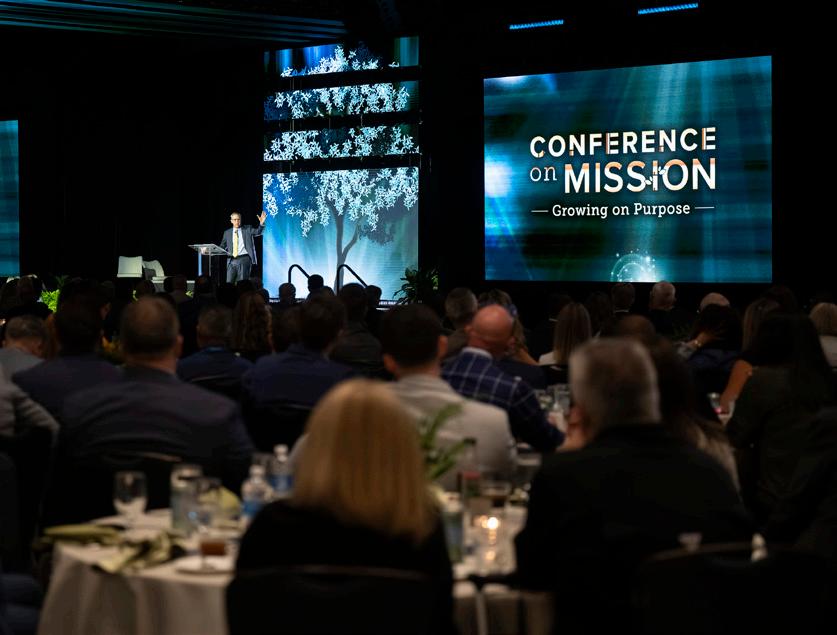

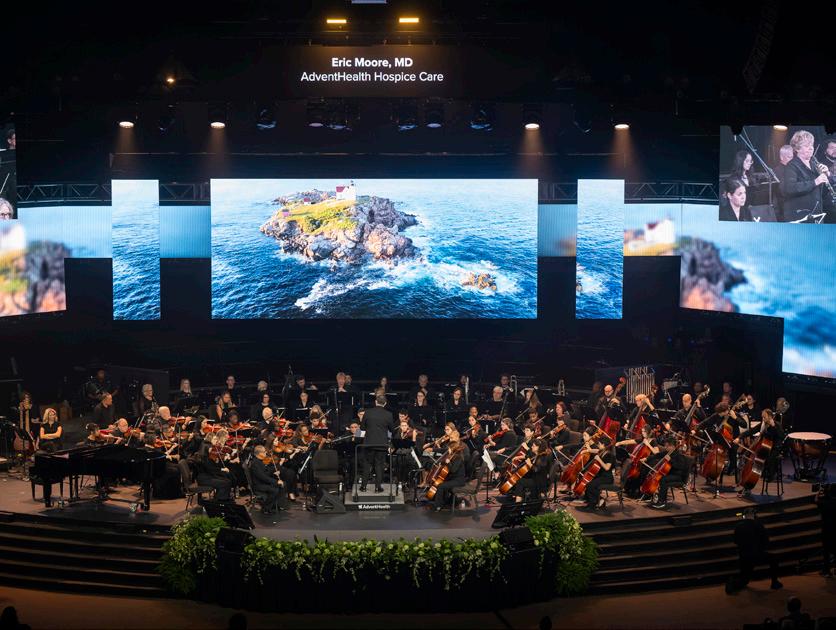

Andrews University is once again taking the measure of current enrollment trends and is also reviewing and celebrating some of its remarkable recent national and regional university rankings.
Andrews University climbed 31 places in this year’s 2026 U.S. News Best Colleges ranking and is now placed among the top 250 national universities in America (#242). This continues the University’s upward movement, having risen 43 places in 2024 from the year prior.
National universities are selected from more than 1,700 U.S. colleges and universities based on several metrics of academic quality and graduate success. Andrews is the only Adventist university to be classified by U.S. News as a national university, with other peer universities ranked as regional colleges or universities.
Andrews also climbed 29 places as a Top Performer on Social Mobility, ranking in the top half of national universities (#189 of 436). Additionally, the University rose in the ranking for Best Undergraduate Engineering Program (#226).
Andrews University was also recognized in Niche’s Best Colleges in America ranking system. Significantly, the University was ranked among the top 10% of Best Christian Colleges in America (#26 of 314) and in the top 15% for Best Academics in America (#239 of 1,612). It placed highest of any Adventist university in both categories and was the only Adventist university to be included on the list of Colleges with the Best Professors in America (#329 of 1,595).
Andrews was also recognized as the #1 Most Diverse College in America (#1 of 1,612) and the #1 Best Small College in
Darren Heslop
Michigan. Moreover, Niche recognized several of Andrews’ academic programs as among the nation’s best, including architecture, physical therapy, psychology and religion.
“These rankings reflect the exceptional professors and programs of study that students can find at Andrews. Here they’ll experience the transformative learning opportunities they’d expect of a highly ranked national university within our close-knit, supportive faith community,” says John Wesley Taylor V, University president.
This fall, Andrews University saw significant growth in its freshmen class, with a 13% enrollment increase of FTIAC (First Time in Any College) students compared to last year. However, due in part to visa challenges, there was a 43% decrease in international students compared to last year. As a result,

the University’s headcount enrollment for fall 2025 was 2,967 students, reflecting a 2% decrease from last year.
In addition to the fall census report, the University measures its unduplicated headcount, which includes the total number of students enrolled at Andrews over a 12 month period. Approximately 1,000 additional students are included in this number, demonstrating that several programs do not follow the typical semester schedule.
“We acknowledge that the challenges facing many of our students are real, but we are counting the blessings of our good God.” says Bordes Henry Saturné, vice president for Strategic Enrollment Management, Marketing & Communication.
Founded in 1874, Andrews University is a premier institution of higher education for the Seventh-day Adventist Church. Its main campus is in Berrien Springs, Michigan, but the University also provides instruction at colleges and universities around the world. P
Office of University Communication and Anthony Bosman, learning officer
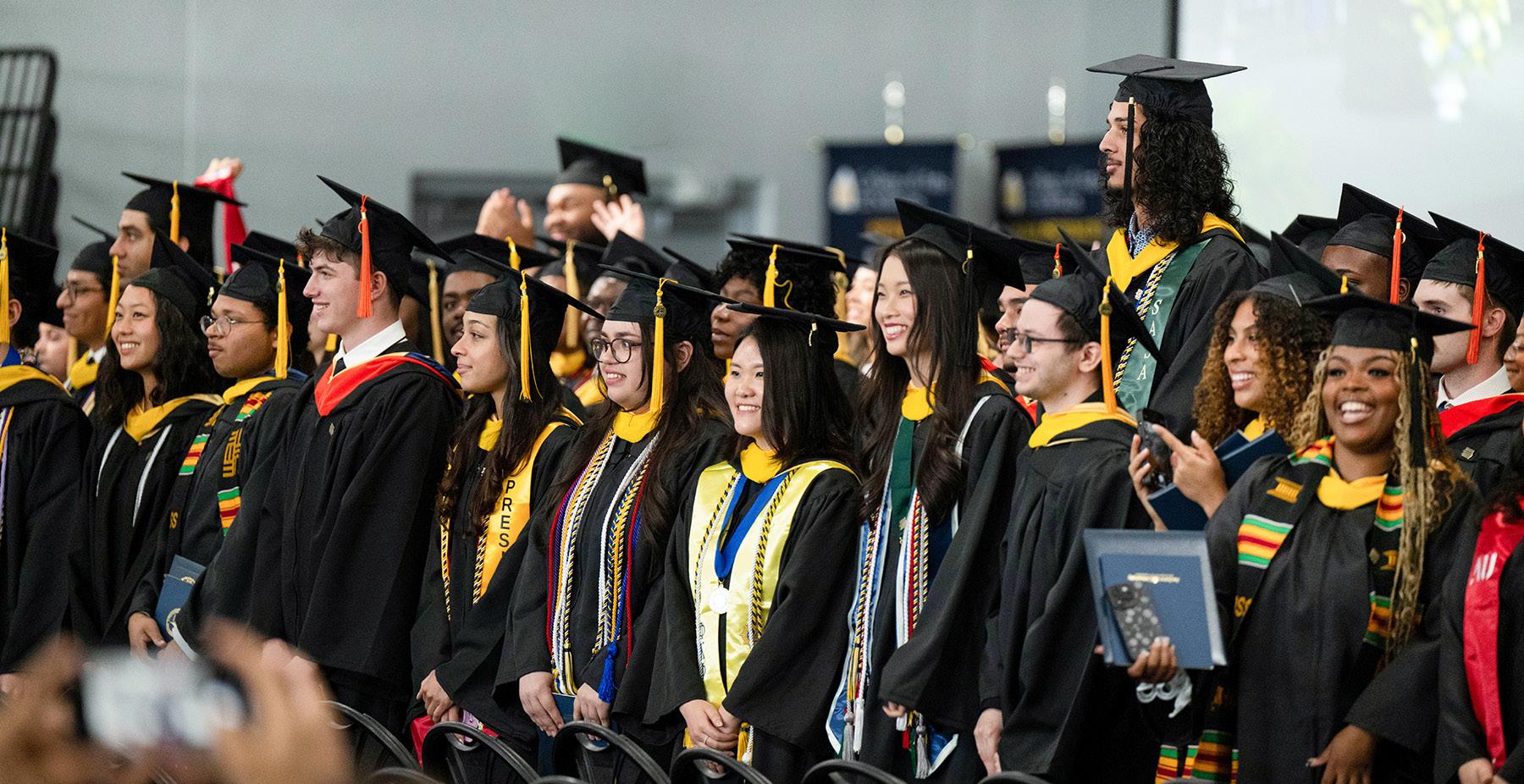
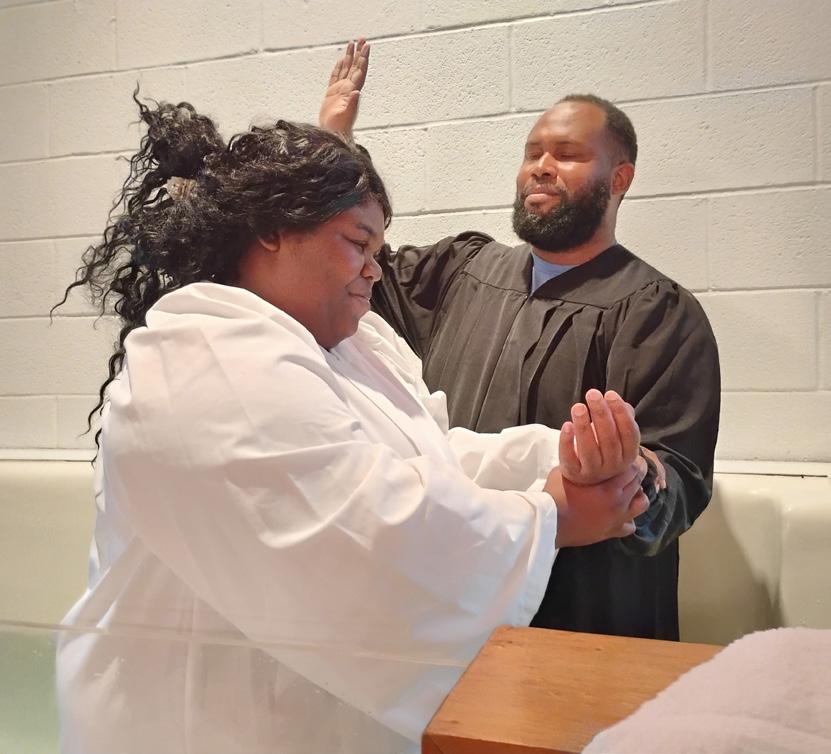
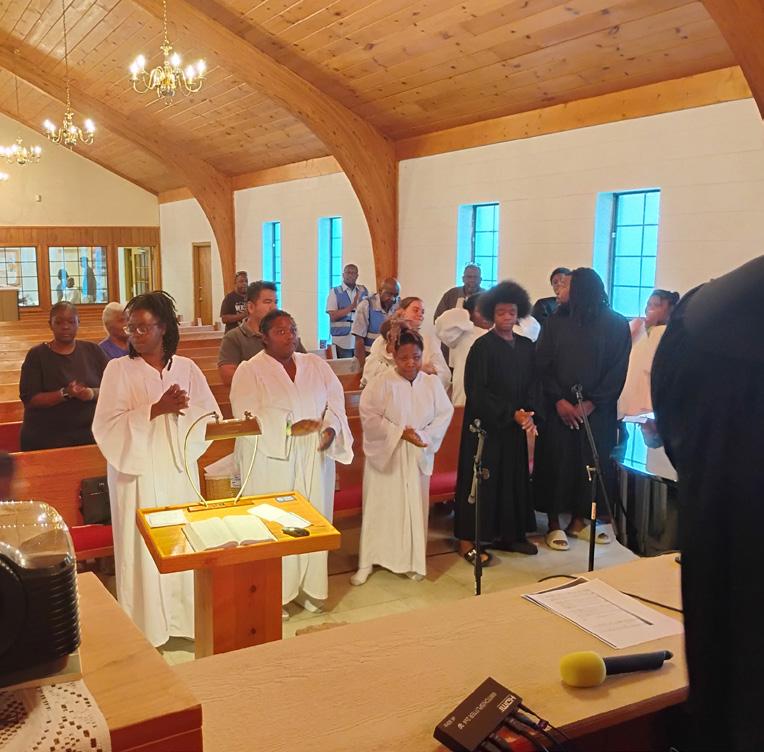
Last fall, shortly after the North American Division launched Pentecost 2025—a territorywide effort to inspire bold, Holy Spirit-led evangelism—Pastor Chaka Samuel was scrolling Facebook when a post stopped him cold: his friend and fellow pastor Kojo Twumasi had baptized 80 people in Toledo through something called the Compassion Project. Inspired, Samuel reached out, hoping to bring the same momentum to his own Indianapolis district.
Originally intended for Muncie, the project shifted to the Eastside Seventh-day Adventist Church when structural issues closed the Muncie church. He believed the vision still had a place.
“We had the funds. We had the opportunity,” he said. “And I believed God still wanted to move.”
That’s when the Lake Region pastor cast the vision before his elders at Eastside.
“I told my members, I don’t want Pentecost 2025 to be an event that comes and passes,” said Samuel. “I want us to experience Pentecost right here.”
They did—and then some.
Over the course of a single week, July 20–26, the church welcomed more than 200
visitors per night, held nightly evangelistic meetings paired with community giveaways, and baptized 74 people—including church members’ loved ones and people from the neighborhood.
To plan, Samuel turned to an unexpected source: ChatGPT. He asked the AI tool for the top five needs in ZIP code 46218. The answers—poverty, food insecurity, housing instability, poor health outcomes and educational gaps—shaped the Compassion Project strategy.
The church served hot meals, gave away backpacks, school supplies, groceries,
diapers, toiletries, laundry supplies and clothes. Each night began with music and a message, followed by giveaways and fellowship.
Advertising was entirely digital. Facebook ads ran for nine days and generated over 1,200 sign-ups. The church hosted a Vacation Bible School complete with inflatables, sprinklers and snow cones, averaging 50 kids per night.
The entire project, including giveaways and marketing, cost about $30,000, funded through a combination of Pentecost 2025 support, Lake Region Conference evangelism funds and other donations and evangelism funds.
“We got a lot of ministry impact for what we spent,” Samuel said. “God multiplied it.”
Each evening, Twumasi preached solid biblical messages built around Seventh-day Adventist doctrine.
“Some people made decisions on the spot,” Samuel said. “We baptized every single night.”
Some questioned baptizing people so quickly, but Samuel pointed to biblical examples like Philip and the Ethiopian eunuch. “It wasn’t weeks of study—it was a response to conviction,” he said.
For each baptism, the team reviewed some of core beliefs with the candidate, including Sabbath, salvation, the state of the dead and the second coming. Then came a decision. “If they accepted Jesus and the foundation of our faith, we baptized them.”
One woman, moments after baptism, let out piercing cries—what Samuel and others saw as a spiritual release. “That reminded us why we don’t delay baptisms,” he explained. “People are seeking freedom now.”
With the campaign concluded, the Eastside team is now focused on retention—a challenge Samuel anticipated from the start.
“We put a plan in place before the week even began,” he said. “We’re focusing on three things: social engagement, discipleship and volunteering.”
A new member’s class called New Beginnings is held after lunch. The weekly sessions focus on church beliefs, mission and community life. “We’ll go deeper with the Bible and the Adventist faith through interactive discussions,” Samuel said.
The church will host two socials each month, including outdoor barbecues and activities using leftover children’s ministry supplies. “We want new and longtime members to bond. I’ve seen how much people connect at church socials.”
And several new members are already volunteering, helping as ushers, assisting with food prep, and joining in Compassion Sabbath outreach.
Eastside Church usually sees about 50 attendees on a good Sabbath. Many are older. Pulling off a project of this scale, Samuel admitted, took faith—and energy.
“There were moments of frustration,” he said. “We were tired. We were overwhelmed. But it brought us together.”
Some of the most moving decisions came from within. The church’s community services director watched her adult son walk forward for baptism. An elder’s lifelong friend made his decision after working security all week. And an elder’s wife, long assumed to be a member, made her public commitment at last.
For a small church in a struggling neighborhood, the experience was more than a campaign. It was a glimpse of Pentecost.
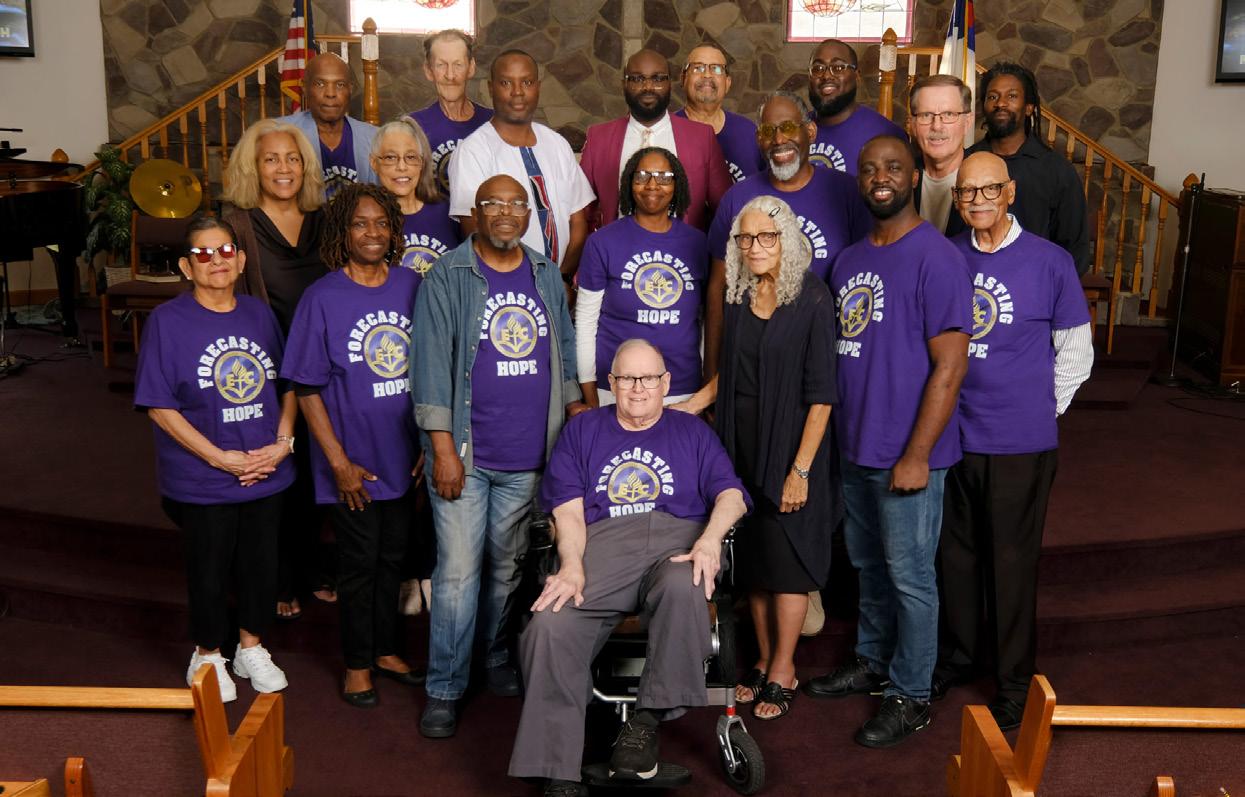
“We asked God for a move,” Samuel said. “We wanted Acts chapter 2, and we got it.”
And as he put it simply, “We’re just getting started.” P
Debbie Michel is editor of the Lake Union Herald.


When Pastor Gordon Lindsay arrived at Fort Wayne’s Body of Christ Seventh-day Adventist Church in August 2024, he found a small, diverse congregation wrestling with identity and largely looking inward.
At the first board meeting he attended, members were discussing a range of matters — none of them evangelism. The small congregation of 25 to 30 regular worshippers was also wrestling with identity. With members from at least 10 nations, including Grenada, Jamaica, Mexico, Uganda, Zimbabwe and the United States, some wondered whether the church should be Caribbean, African
American, African or something else entirely.
Lindsay knew that before the church could reach its community, it had to come together. He invited guest speakers to help bridge divides. Trudean Scott Elliott, from Andrews University’s Counseling and Testing Services, led discussions on the beauty of unity. Claval Hunter, associate director of the university’s Center for Community Engagement, guided members through a vision-casting process that emphasized mission over labels.
The church also hosted “Diversity Days” Sabbaths, celebrating cultures and showing that varied backgrounds could strengthen ministry. Slowly, members began turning their attention outward.
As members learned to embrace their differences and focus on mission, they were getting ready to work together toward a major evangelistic push. For nearly a year, they met weekly to plan “The Plug,” a July 26–Aug. 9 series with Lake Region Conference evangelist Pastor Cody Miller.
In the 40 days before the meetings began, members gathered online at 6 a.m. for prayer and submitted names of people they wanted to see commit their lives to Christ.
The Holy Spirit did not disappoint, and the congregation’s faithfulness was rewarded.
Opening night drew more than 200 people, including 150 children. Attendance averaged at least 70 guests each evening. By the series’ end, 42 people had made decisions for Christ through baptism or profession of faith. Pastor Lindsay said this illustrates God’s challenge is never with the harvest, but more so the reapers. “The harvest truly is ripe!” said Lindsay
Among the newly baptized members was the wife of a Baptist leader who attended every night and streamed the meetings live on his Facebook page. Another decision came from a man who had spent a decade in prison. Another was from a young mother and her four children.

For the evangelist Miller, the series was about more than numbers. He is deeply aware of the national trend showing young adults are largely absent from churches. Miller, 28, believes the way to win back anyone, especially youth and young adults, is to show them God’s love.
Although they were giving away groceries, diapers, school supplies and other items each night, there was an intentionality to the plan. “Everything we were doing, drawing people in with different gifts and different items that we were giving away, it was all to connect people to the church so that we could serve them, so that we could laugh with them, talk with them, get to know them, said Miller. “And so one of the key things that we were hearing from our guests was every night when we came into the door, we felt loved. We felt welcome. We felt accepted, and that was our goal.”
He recalled with amusement one evening when a guest had left a dog in the car and one of the security guards went out to take care of it. “He watched the dog and fed the dog,” Miller said. It was an act that didn’t go unnoticed by the visitors with one telling him, ‘I’ve been to other churches and they don’t really care about my dog.’”
To relate on a personal level with the visitors, Miller was intentional about connecting.
“My goal is to always sound like we’re just having a conversation. I’m not preaching to you, I’m teaching to you and I want you to talk back to me. I try to talk to them like I’m one of their friends.”
Meanwhile, Pastor Lindsay said he has noticed a vibe shift in the congregation. “Mission solves all problems,” he said. “The more work the members do, the fewer the problems.”
Now, the church is turning its momentum into ongoing discipleship. Leaders are pairing longer-serving members with new members as “connection partners” to provide support, Bible study and encouragement. A yearlong discipleship program will cover foundational beliefs, spiritual disciplines and personal growth.
Plans also call for members — both new and seasoned — to go into the community together, sharing the hope they have found.
“We want to focus on keeping people in church now,” Miller said. “It’s about walking alongside people and making sure they know they’re part of a family.”
Debbie Michel is editor of the Lake Union Herald.

Michigan Conference churches and schools held one of the largest coordinated evangelistic efforts in years, with more than 100 public prophecy seminars launched in October.
“What a privilege we have as a conference to collectively engage in the ministry of harvesting in this conference-wide year of public evangelism,” said Cody Francis, ministerial director for the Michigan Conference.
Most meetings began Friday, Oct. 3, under the theme Keys to Revelation. Yard signs, banners, billboards, and social media ads appeared across the state, with hundreds of thousands of invitations distributed.
Francis emphasized that public evangelism goes beyond baptisms. “Seeds of truth are sown, Bible study interests are cultivated, and those who have already accepted Jesus are preserved in their faith,” he said, citing Ellen White’s counsel that public proclamation is “the greatest and most efficient
mode of witnessing to the truth and making it impressive.”
This spring and summer, 30-40 meetings took place statewide, drawing hundreds. In Brighton, an AMEN free dental clinic paved the way for meetings that led to baptisms. In Marion, a small central Michigan church more than doubled its attendance when community guests packed the fellowship hall. In Port Sanilac and Bad Axe, dozens of non-Adventists attended.
Schools and Spanish churches have been active as well. Students shared the message, and Spanish congregations held small groups that culminated in weeklong evangelistic series. Francis noted, “God is on the move throughout Michigan!” P
Cody
Francis with Herald staff




The parking lot of the Berean Transformation Center of the Seventh-day Adventist Church in South Bend was transformed into a place of hope and celebration on Sabbath, Sept. 6, 2025.
A beautifully decorated banquet table, complete with candles and elegant touches designed by Pamela Daly, director of logistics and operations for The Welcome Table, set the stage for an unforgettable gathering.
Volunteers from across the city served a hot meal from a local food establishment, carefully plated and presented with dignity. As the afternoon went on, the turnout exceeded expectations. When the pre-prepared meals ran out, volunteers quickly rallied to provide additional meals, including bringing in tacos and other options to make sure no one left hungry.
Before the meal was served, Desmond Sturrup, associate pastor of Berean, offered
an uplifting word of encouragement, reminding everyone present that they were valued, seen and loved.
This commitment to action and compassion was made possible through weeks of hard work and collaboration. Claval Hunter, senior pastor of Berean, Carl Hetler, head of homeless services for the City of South Bend, and the Welcome Table team dedicated six weeks to coordinating volunteers, aligning resources and ensuring every detail of the day came together.
Partnerships with Naxos Neighbors, Oakland Mental Health Services, the YWCA,


E The entire event was captured on video by Justin Smith and photographed by Justin and Andrew Mptia, preserving the moments of service, joy and community connection for The Welcome Table and the wider public.
and many other organizations brought additional layers of support. Free haircuts, testimonies of resilience and heartfelt words of gratitude from participants reminded all involved that true ministry is about presence, relationship and compassion in action.
Reflecting on the event, Hetler said, “When city leaders, churches, and neighbors come together like this, it shows our unhoused residents that they are not forgotten. What we did here is more than a meal, it’s a demonstration of the community’s commitment to walk with them toward stability and hope.”
One guest summed it up best:
“Out here, it’s love, compassion, and care; it’s God everywhere. I already got my blessing, so I came back to show my appreciation.”
Reflecting on the day, Hunter extended heartfelt thanks to everyone who made the Welcome Table possible:
“Because of your service and generosity, we were able to bring hope and encouragement to our brothers and sisters who long for a place to call home and the opportunity to thrive.”
He also expressed his desire for South Bend to keep the momentum going:
“I would love to hear your ideas on how we can continue coming together to host more community engagement projects in the future.” P
Habi Gasigwa serves as executive director of The Welcome Table, a ministry reaching people who are trafficked, unhoused, or struggling with mental health.
If you were to drive into the parking lot of the Seventh-day Adventist Church in Paw Paw, Michigan, on the second Wednesday of any month between April and November, you would notice several cars and pick-ups lined up in front of the church. You would also take note of the message on the electronic church sign: Feeding America at Noon Today.
Before long, volunteers begin setting up traffic cones in a go-kart track pattern. You soon realize this is designed to organize the growing line of cars into a manageable flow. One by one, additional cars arrive and are directed into formation to patiently wait for the distribution to begin. The “early birds” arrived before sunrise.
Soon there are greeters at the entrance and along the route, welcoming each driver with a warm smile and kind words. Seeing these vehicles in position hours before the event begins tells a deeper story – some offer their unique and often difficult reasons for coming.
“I came today because my spouse lost his job and we have nothing to eat without this assistance. I have several children, and we just can’t keep up with the cost of food. I am dealing with a major health issue and can’t support myself. Our electricity has been cut off and our living conditions are deplorable.” Each car represents real struggles, and appreciation is often voiced for the Adventist church’s help.
Not all those who enter the parking lot come with needs. Early one morning, a nice-looking pickup truck drove in and the driver approached one of the organizers with a message: “I want you to know that the people of the community have taken note of what

your church is doing, and we are so grateful. Here is a little something ($100). We want to support what you are doing.”
As the morning passes, the lines of cars increase and fill the entire lot with rows of vehicles, each awaiting their turn for the process to begin. At 11:00, the activity really picks up as 25–40 volunteers arrive and take their positions. Although most of these volunteers, young and old, are church members, several community individuals have joined the effort. Church members relish the opportunity to work side by side with these caring people. Some of those receiving food have subsequently attended church functions and meetings.
About 11:20, the Feeding America truck arrives and positions itself for unloading. Volunteers encircle the truck and pull up tables to each side. Some items are prepackaged, while others are in bulk containers and need to be bagged. Once everything is ready, a parade of wagons—often pulled by the youth of the church when school is out—begins circling the truck, loading items for each family. At that point, the line of cars begins moving forward, and each vehicle is loaded with its allotment of food. The process is well managed, and the choreography of movement is a sight to behold.
From the loading zone you’ll hear: “Thank you,” “God bless you,” “You folks are wonderful,” “See you next month!” Big smiles and friendly waves are exchanged as each vehicle leaves the parking lot and blends back into the community.
This outreach activity serves up to 230 households a month (as many as 650 individuals) and has given the Paw Paw Adventist Church a profound sense of working together for a good cause. The fee to host this event is built into the local church budget, and the message of Acts 20:35 is experienced by all participants: the blessings of giving outweigh those of receiving. P
David Burghart is a member of the Paw Paw Church and coordinates their Feeding of America program.

A few men at Epic Suburbs’ Men’s Life Group were sharing how they wished their children and grandchild could be blessed to know Jesus. The “young” grandfathers, Bill Puga, Jack Gabriel, and Joe Ventura, quickly realized the need to go beyond wishing and, with the Holy Spirit, do something about it.
Since Epic Suburbs operates out of a shopping mall, they didn’t have to look far to find children. The group found others with a passion for children’s ministry and together they began to pray and brainstorm. They developed the idea of having a rotation of VBS
programs throughout the year and inviting the kids and families they encountered at the mall. With no budget, they decided to trust the Lord and set a date for the first VBS. With a lot of prayer, planning, and prep, the first shopping mall VBS began in June 2025.
On Wednesday, Sept. 17, eight senior education majors from Andrews University gathered at the Lake Union Conference office in Berrien Springs for Professional Day, a daylong event designed to prepare soon-to-be graduates for the realities of entering the teaching workforce.
Since then, it has been a major blessing. Mall VBS has brought a number of benefits: it has allowed us to be invitational with those parents seeking a Christian experience for their kids. The kids themselves wear smiles, saying things like “I’m connected to Jesus” and “I love those people.” It has also made our church visible to more people. Some have already been attending services at Epic. Parents have been seeing their older kids teaching their younger siblings at home about Jesus and doing a mini-VBS with their friends!
Unexpectedly, it has given us the opportunity to minister to some special needs kids and their families. It has opened our eyes to the needs of our community that we did not previously see. To the grandfathers’ joy, the grandchildren attended and were greatly blessed. P
Jon Remitera pastors the Indiana Conference Epic Church.

“For our graduating seniors, this is a chance to get a feel for what the hiring process looks like,” said Ruth Horton, Lake Union director of education. “They’ve studied, they’ve completed student teaching, and now they’re preparing to enter the workforce. Professional Day gives them a practice run—an opportunity to meet administrators, go through interviews, and hear what school leaders are really looking for.”


Michelle Bacchiocchi, associate professor at the School of Education and director of student teaching at Andrews University, has seen firsthand how much the day means to seniors. “For many of them, this is the first time they’ve experienced a professional setting outside of student teaching,” she said. “They come in a little nervous, but they leave feeling empowered and encouraged.”
Bacchiocchi noted that the Ed Talks were a highlight for the students this year. Presenters included:
James Bermingham, systems executive director for Diploma Options Management, who outlined the qualities administrators seek in new hires.
Maurice Byrd, retired superintendent of an Illinois school district and volunteer in his local Adventist school, who explained how student-led assessment can motivate learners, as well as best practices for engaging school boards.
Wadzanai Bepe, Lake Union special education consultant, who emphasized strategies for embracing and nurturing diverse learners from the very beginning.
Bradley Sheppard, retired assistant superintendent of instruction for Elkhart Community School and his wife Clem Sheppard, retired world language department chair, St. Joseph Public Schools, who discussed the differences between parochial and public schools.
One poignant moment for the students was a point Bermingham made about the first year of teaching. He told them that selfcare is important and that teacher burnout is real. “However, that first year you need to immerse yourself,” he told them. “Get to know the system, be proactive, get involved, be engaged, and then as you progress you can balance it more.”
Professional Day has been a fixture in the Lake Union for more than 20 years, offering a blend of professional learning and practical experience. Horton explained that while the day benefits the students, administrators also appreciate the opportunity. “It’s really a win-win,” she said. “Students meet potential employers and practice their skills, while administrators get a first look at the next generation of Adventist teachers.”
Bacchiocchi said that the students talked about how inspiring it was to hear from such experienced professionals. “They realized they’re not just preparing to teach a subject, they’re preparing to impact lives.”
The afternoon gave students a chance to put those lessons into practice. In rotating 15-minute intervals, they sat across from principals and superintendents for mock interviews. Each round offered a new set of questions and new feedback. “It’s intense, but invaluable,” Horton said. “Administrators are looking at these young people as potential colleagues, while students are practicing how to present themselves with confidence.”
Afterward, Bacchiocchi moderated a panel of administrators, giving students the chance to ask candid questions about the hiring process and expectations for new teachers. This is where the students lean in. “They want to know, what do I need to do to succeed in that first year? What do administrators value most? And the panel doesn’t hold back,” said Bacchiocchi.










The day concluded with Nicole Mattson sharing “Surviving the First Year of Teaching,” a practical and uplifting talk on navigating the challenges of a first classroom assignment.
This year’s participants included: Jordan Anderson, Askah Morara, Keira Hodgins, Katlin Nelson, Olivia Jordan, Rohannah Riley, Eleanor Joyce, Jenae Rogers, Leilani Lopez and Myah Riggs-Wright. Together, they represented a range of majors from elementary to secondary education, including specialties in music and mathematics.
Bacchiocchi expressed gratitude for the Lake Union’s role in hosting the event. “Our students don’t just hear about what’s expected—they get to experience it. That’s an incredible gift. We’re thankful the Lake Union has made this investment year after year.”

















The impact, she added, goes beyond the day itself. “Some of our students have actually been hired after Professional Day because administrators see their potential here first. It’s an amazing bridge between Andrews and the field.” P

































Our 2025 reader survey is complete and the results are in! But before we get to the findings, a big thank you to the 243 respondents who gave us their candid feedback about the Herald content in print and on social media. For the first time, we translated the survey into Spanish and received 75 responses. We took notes and are redoubling our efforts to continue bringing you relevant news and information, as well as stories to deepen your relationship with God.
• We published in The Lake Union Herald magazine April, May/June and July/August 2025 issues, on our website and social media, promoted via our conferences and Andrews University newsletter and social media.
On a scale of 1 to 10, the overall content was valued at 7.49
• Current matters such as news and mileposts
• Articles featuring youth/young adults MOST POPULAR CONTENT:
SOME OF THE MOST MEMORABLE TOPICS OF THE PAST YEAR:
• Return to Palau, evangelism despite COVID; bold initiatives in Adventist Christian education.
• Feature more stories from the field/ churches
SOME OF THE LEAST FAVORITE THINGS:
• Difficulty finding time to read each issue
• Avoiding key issues
• Font size too small
COMPARISONS BETWEEN ENGLISH AND SPANISH RESPONDENTS:
• Hispanic respondents dominate the 35-49 age group category while English responses by 65–79-year-olds hold prominence.
• Hispanics also tend to read the occasional issue, compared to English who read most issues.
• Hispanics are also highly more likely to go online to read additional content and to also use social media.
• Include more health content AGE
• Both groups are most interested in online content featuring personal faith stories/testimonials.
Congratulations to the winners of the Apple AirPods Marcella Morales, Jacqueline Kinsman and Charles Truly












EASTON, Donald H., age 92; born Oct. 31, 1932, in Bloomfield, Ind.; died Oct. 11, 2025, in Bloomington, Ind. He was a member of the Bloomfield SDA Church in Bloomfield, Ind. He is survived by his wife, Patty R. (Jones) Easton; sons, Donald (Cathi) Easton, Jeff (Becky Meyer) Easton, Bryan (Stella) Easton; daughter, Diana Easton; brother, John Easton; sister, Mary Easton; four grandchildren; and four great-grandchildren. A funeral was conducted by Pastor Lal Awma on Oct. 16, 2025, in Scotland Cemetery in Scotland, Ind. Within the Lake Union, the officiating pastor or church communication leader is responsible for submission of information to this column. Forms are available in print format, or they can be filled out and submitted directly online. Milepost forms are available at www.lakeunionherald.org. Conference addresses and phone numbers are listed in the masthead on the inside front cover.
GUTHRIE, Elizabeth (Winn), age 104; born Dec. 9, 1920, in West Palm Beach, Florida; died Sept. 27, 2025, in West Palm Beach, Florida. She was a member of the First SDA Church of Riviera Beach in Riviera Beach, Florida. She is survived by nieces and nephews, Clara Winn, Ulysses Winn (Alice), Faye Wilson (William), Sylvia Winn, Rodney Winn, Druscilla Winn, Linda Cook, Sabrina Winn, Cherry Winn, Beverly Jean Winn, Sherman Jr., Alan Winn, Bruce Winn, Collen Morris (Roosevelt), Dawn Winn, Edie Weathers (David), Kevin Winn, Mark Winn; and countless grand-nieces and nephews and cousins. A Celebration of Life was conducted by Pastor Kenton Perrin on
Oct. 12, 2025, at the First SDA Church in Rivera Beach, Fla.
JONES, Randall “Randy” S., age 66; born Dec. 7, 1958, in Lebanon, Mo.; died Sept. 29, 2025, in Kalamazoo, Mich. He was a member of the Paw Paw Seventh-day Adventist Church, in Paw Paw, Mich. He is survived by his wife, Cynthia “Cindy” (Harvath) Jones; sons, William (Maria) Jones, Zachary (Shenira) Jones; brothers, Ronald (Teresa) Jones, Daryl (Shirley) Jones; sisters, Barbara (Charles) Randall, Vivian (Steve) Scott, Cathie Dunigan; and three grandchildren. A funeral interment was conducted by Pastor Sean Reed on Oct. 6, 2025, at East Hickory
Corners Cemetery in Hickory Corners, Mich.
PITTMAN, Maxine (Dowden), age 86; born Jan. 19, 1939, in St. John’s Newfoundland, Canada; died Sept. 10, 2025, in Berrien Springs, Michigan. She was a member of the Pioneer Memorial Church in Berrien Springs, Mich. She is survived by her husband Thomas D. Pittman; daughter, L. Monique Pittman; son-in-law, Paul D. Smith Jr.; nieces, Cheryl Dowden and Lori Mitchell Roeser; and nephew, Kenneth Mitchell. A memorial inurnment was held by Pastor Ante Jeroncic and Pastor Davide Sciarabba on Oct. 4, 2025, at the Andrews University Seminary Chapel in Berrien Springs, Mich.


Shop for New/Used Adventist Books: TEACH Services offers used Adventist books at www. LNFBOOKS.com or new book releases at www.TEACHServices. com or your local ABC. Authors let us help you publish your book with editing, design, marketing and worldwide distribution. Call 706-504-9192 for a free evaluation.
Move with an award-winning agency—Apex Moving + Storage partners with the General Conference to provide quality moves for you. Call us for all your relocation needs. Contact Marcy Danté at 800-766-1902 or visit our website: apexmoving. com/adventist.
Fill your life and home with a Christian spirit of Christmas. LifeTalk Radio plays Christmas music all through December with special concerts nightly at 8 pm EST, from Dec. 6-25. Enjoy Christmas music 24/7 at LifeTalk.net
Considering Rural Living?
Explore Greeneville, TN! Located near the Smoky Mountains, Greeneville Adventist Academy has an accredited SDA K-12 day school program, supported by two constituent churches, prioritizing the Bible, evangelism, mission trips, academics, and a high-quality music program (voice, band, bells and strings). MyGAA.org; 423-639-2011.
Wings of Life – Follow the journey of frontline missions in Central America as we plant churches, conduct health outreaches and more. Read the exciting stories, pray for us, and consider volunteering on a short-term trip. Follow, engage and partner with us in our mission of saving lives. Visit www.wingsoflife.net
Lake Union Conference seeks IT Support Specialist and Systems Admin to provide oversite and management to network and cloud-based services; deploy and manage endpoints as needed; install software and ensure security updates are applied in a timely manner. Answer questions and resolve computer problems for end users including hardware, software, printing, word processing, email, collaboration software, etc.; work with IT Director to setup, maintain and support network infrastructure onsite and at Conference offices as needed; Provide day-to-day technical support as needed and other duties as assigned by the Information Systems Director. For full job description, please visit lakeunionherald.org/advertising/ classifieds
Andrews University seeks qualified applicants: Andrews University is seeking qualified Seventh-day Adventists who may fill open roles in fulfilling our mission to Seek Knowledge, Affirm Faith, and Change the
World. If this is of interest to you, please check out our current openings at: andrews.edu/jobs
Pacific Union College seeks qualified candidates to fill open positions in fulfilling our mission to Learn with Purpose, Rise in Faith, and Serve in Love. Beautiful mountain campus, minutes to shopping, an hour+ drive to ocean and skiing. If interested, please check out our current openings at: puc.edu/campusservices/human-resources/ current-job-postings.
Union Adventist University is searching for applicants for the position of Life Coach in Student Success. This is a full-time, nonexempt position. A bachelor’s degree is required, master’s preferred. Duties include serving as a life coach/academic advisor for assigned freshman, working with high-risk students and providing specialized services, assisting freshman with registration, providing accountability coaching for academic probation population and other duties. Please see the job description and instructions for application at uau.edu/ employment.
Union Adventist University is seeking applicants for EMS Coordinator in the International Rescue and Relief (IRR) Program. This is a full-time exempt position with excellent benefits. The EMS
Coordinator is responsible for developing and managing the EMS component of the program and includes both teaching responsibilities and program administration. EMS Instructor Certification is required. Please see the job description and apply at uau.edu/employment.
Union Adventist University seeks applicants for Doctor of Physical Therapy Program Director to provide leadership to the program and oversee all aspects of the DPT Program including responsibility for communication, program assessment and planning, fiscal management, faculty evaluation/ professional development, curriculum development, accreditation, and other duties. This is a full-time exempt position with excellent benefits including tuition assistance. See the full job description and apply at uau.edu/ employment.
Union Adventist University seeks applicants for SALT (Soul-winning And Leadership Training) Program Director to provide administrative oversight and ensure the strategic development of the program in harmony with It is Written. This position also includes faculty teaching responsibilities. A master’s degree in religion/ ministry/theology is required. This is a full-time exempt position with excellent benefits including tuition assistance. See the full job
The Lake Union Herald cannot be responsible for advertisements appearing in its columns, and reserves the right to edit ads in accordance with editorial policies. The Lake Union Herald does not accept responsibility for typographical errors. Submission eligibility guidelines are listed at http://www.lakeunionherald.org.
description and apply at uau.edu/ employment.
Union Adventist University seeks applicants for SALT (Soulwinning And Leadership Training) Program Outreach Coordinator/ Registrar to be responsible for planning the Program’s outreach, assisting the director with programming, training, interviewing and advising students and other duties. This is a full-time exempt position with excellent benefits including tuition assistance. Please see the full job description and apply at uau.edu/employment.
Union Adventist University is seeking qualified applicants for Research and Instruction Librarian. This position develops and provides reference and library instruction to diverse groups of students, faculty, staff, and community visitors, using modalities suited to the individual, classroom, or online environments. ALA-accredited Master of Library and Information Science or equivalent required. See job description and apply at uau.edu/employment.
Union Adventist University is searching for applicants for Special Events Director. This position is responsible for planning, organizing, and executing a wide range of alumni and university promotion events to enhance stakeholder engagement, foster community spirit, and promote the university’s mission and values. This role involves collaborating with various departments,
managing logistics, overseeing event budgets, and ensuring successful delivery of events that meet the university’s standards. Please apply at uau.edu/ employment.
Union Adventist University has an opening for a Nursing Program faculty to prepare undergraduate students to successfully complete the Nursing Program Bachelor of Science (BSN) curriculum and pass the National Council State Boards of Nursing Examination (NCLEX-RN). Union Adventist University Nursing faculty have a philosophy of partnering with students to help them reach their
goals while caring for students holistically. Doctoral degree preferred; Master’s degree in nursing required. Please apply at uau.edu/employment.
Mid-America Union Conference is seeking applications for a full-time associate treasurer to support treasury operations, including budgeting, financial reporting, audits, and compliance. Applicants should have denominational experience in accounting/finance, strong analytical and interpersonal skills, and a commitment to mission-focused stewardship. This position offers excellent
benefits. Qualified applicants, please send your resume to Raylene Jones at raylene. jones@maucsda.org.
IT IS WRITTEN is seeking qualified Seventh-day Adventist professionals who desire to serve the Lord through media evangelism. Our current full-time positions include: Director of Media Production, Trust Officer in Planned Giving and Trust Services, and Graphic Designer - Web. For more information and to apply online for these and other available positions, visit itiswritten.com/employment.


GENERAL EVENTS
Oct. 31–Nov. 1: Andrews Autumn Conference on Religion and Science
Nov. 2–3: Andrews University College Days
Nov. 7–10: Transfer/Health Professions Weekend Experience
Nov. 8, 11:45 a.m.: Honors Church, Seminary Chapel
Nov. 12, 7 p.m.: Ambassador Talks (Virtual) Dec. 4, 4–6 p.m.: Fall Honors Thesis Symposium (formal talks only), Buller Hall
HOWARD PERFORMING ARTS CENTER EVENTS
For more information on the following events and to purchase tickets, call 888-467-6442 or 269-471-3560, or visit howard.andrews. edu.
Nov. 1, 7:30 p.m.: Andrews University Choirs Fall Concert
Nov. 2, 7 p.m.: Howard Center Presents: Reggie & Ladye Love Smith
Nov. 7, 7 p.m.: Andrews Academy Vespers Concert
Nov. 8, 7:30 p.m.: Symphony Orchestra Fall Concert
Nov. 16, 4 p.m.: Sunday Music Series: Junqi Sophie Tang
Nov. 22, 8 p.m.: Wind Symphony Christmas Concert
Dec. 6, 7:30 p.m., & Dec. 7, 4 p.m.: Department of Music Christmas Extravaganza
Dec. 13, 7 p.m.: Andrews Academy: Christmas Pops Concert
Dec. 15, 7 p.m.: Ruth Murdoch Elementary School: Instrumental Christmas Concert
Oct. 31 – Nov. 2: Young Adult Retreat, Camp Akita
Nov. 1-8: Evangelismo Metropolitano, Iglesias Hispanas de Illinois
Nov. 15-22: Caravana de Evangelismo, Iglesias hispanas designadas: se determinarán las ubicaciones específicas.
Nov. 24-28: Office Closed – Thanksgiving
Dec. 22 – Jan. 1, 2026: Office Closed –Christmas / New Year’s
Nov. 7-9: Health Summit, Timber Ridge Camp
Nov. 14-16: Young Adult Retreat, Timber Ridge Camp
Nov. 26-27: Office Closed – Thanksgiving
Dec. 24-25: Office Closed – Christmas
Dec. 31 – Jan. 1, 2026: Office Closed – New Year’s
Nov. 8-15: Semana de Evangelismo Juvenil
Nov. 12: Lake Region Education STEAM Day
Nov. 22-29: Semana de Consagración
Dec. 20: Concierto y Comida para los Jóvenes
Oct. 31 – Nov. 2: Public Hi-C, Camp Au Sable
Nov. 7-9: Northwoods Family Retreat
Nov. 26-27: Office Closed – Thanksgiving
Dec. 24 – Jan. 1, 2026: Office Closed –Christmas / New Year’s
Nov. 1: Shockwave Youth Sabbath - Fond du Lac
Nov. 15: The Table Young Adult Sabbath, Wausau
Nov. 26-27: Office Closed – Thanksgiving
Dec. 6: JAHWI Youth Rally, Milwaukee
Dec. 23 – Jan. 1, 2026: Office Closed –Christmas / New Year’s
Nov. 16-19: Year-End Meetings
Nov. 26-27: Office Closed – Thanksgiving Dec. 22 – Jan. 1, 2026: Office Closed –Christmas / New Year’s
Events listed were scheduled to proceed at press time. Please call ahead or check event websites before making plans to attend.
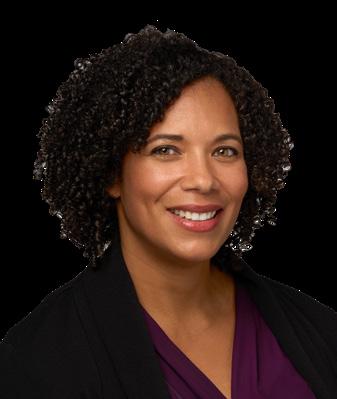
E JENNIFER GRAY WOODS
Now that the Johnson Amendment doesn’t apply to churches, is it OK for pastors to start promoting and endorsing candidates at church?
As discussed in the May 2024 “Ask the Lawyer,” the Johnson Amendment is part of the U.S. tax code that prohibits tax-exempt charitable organizations, including churches, from participating or intervening in political campaigns either on behalf of or in opposition to political candidates. Though rarely enforced, organizations that violate this restriction could end up losing their tax-exempt status. This restriction doesn’t apply to other types of organizations that qualify for tax-exempt status under different sections of the Internal Revenue Code, such as 501c4 or 501c6 organizations.
The rationale for restricting these types of political activities for 501c3 organizations is that in addition to being tax exempt, these organizations also allow their donors to make tax deductible contributions, which aren’t allowed for other types of 501c organizations. Because of this, the government has found that there is a compelling interest, for 501c3 organizations in particular, not to engage in partisan political activity as it is out of line with the mission of charitable organizations.

Over the years there have been some who have pushed to repeal the Johnson amendment, at least as it applies to religious organizations, arguing that it suppresses the First Amendment rights of free exercise of religion and free speech and that
pastors should not be constrained from speaking for or against political candidates or parties. And recently, the IRS has changed its position on the Johnson amendment by reinterpreting the amendment’s application to churches. Now, churches are allowed to endorse political candidates in their “usual channels of communication” without losing their tax-exempt status.
The Seventh-day Adventist Church, however, has a longstanding history of advocating on behalf of religious liberty and separation of church and state. We have seen through history that liberty of conscience is threatened when church and state unite. Because of this, the church has stayed clear of endorsing or promoting political candidates. And this is a position that predates the passage of the Johnson amendment and remains intact with the amendment’s reinterpretation.
Our church’s position has been that while individual church members are free to support or oppose political candidates or even run for office themselves, it is not the role of the church to involve itself with partisan politics.
So even though it is now legal for pastors to endorse political candidates from the pulpit, our church’s position has not changed, and we would encourage us to remember that all things that are legal are not necessarily moral. P
Jennifer Gray-Woods is the Lake Union legal counsel, as well as its Public Affairs and Religious Liberty director.

Let me be real. Growing up, my life was like a split screen. I lived with my father’s parents during the week and with my mother’s family on the weekends.
The two homes couldn’t have been more different. At my grandparents’ house there were rules— curfews, chores, Sabbath mornings at church. At my mom’s, there were none. I could stay out all night, hang out with whoever I wanted and do whatever I pleased. As I got older, I drifted more toward my mom’s side, chasing that so-called freedom.
That freedom came at a cost. By high school I was selling drugs, partying and living what I considered the high life. At first it felt exciting, but after a while it became the same tired cycle—making money, losing it, starting over. Deep down, I knew I wanted something more.
Earlier this year, at 24, I finally moved back in with my grandparents. Harold Lumsey, an elder at the Indianapolis Capitol City Church, and his wife Inell welcomed me even though my life was a mess. When I came home drunk, they didn’t kick me out. Instead, they showed patience. They simply asked me not to come in intoxicated, so sometimes I’d sit at the park until I sobered up before walking inside. They kept their door and hearts open to me.
This fall, they invited me to an evangelistic series called “The Plug” at the Capitol City Church. I showed up the first night not knowing what to

expect. As soon as Pastors Cody Miller and Eliot Brooks started preaching, I realized this was different. They spoke my language. Pastor Cody talked about being a “Christian atheist”—someone who says they believe but lives like God doesn’t exist. That hit home. He also used the term “body bag” to describe life without Christ. On the streets, that meant violence and death. Hearing it used in connection with faith opened my eyes.
That first night I left feeling something I hadn’t felt in years—happy. It wasn’t just the preaching. The people remembered me from when I was a young boy attending Sabbath School, church and Lake Region summer camps. They hugged me and welcomed me like I was a celebrity. For someone used to cold stares and fake smiles, that kind of love felt overwhelming.
Most people were coming to “The Plug” for the food and baby diapers the church was giving away. I wanted to give something back. When I heard the church was offering free haircuts, I brought my tools and volunteered. Cutting hair has always meant a lot to me because it’s something I can start and finish. After so many unfinished chapters in my life, completing a haircut and seeing someone smile gave me hope.
The more I came to “The Plug,” the more I realized I couldn’t keep living in the old cycle. Too many of my friends had already died young. I didn’t want to wait until it was too late. I made the decision to give my life to Christ and was baptized on Friday, Sept. 26. That day, surrounded by my grandparents and church family, I felt hopeful. For once, I wasn’t just surviving—I was building. And this time, with God’s help, I’m determined to keep moving forward. P
Michael Huff didn’t come for the sermon.
He had just moved to Fort Wayne, Indiana, fresh from a work-release program. Friends told him about a back-to-school giveaway at a red brick church in a hardscrabble neighborhood. There was one condition. To get the supplies, you had to sit through the hour-long service. Michael was fine with that. His girlfriend, Tonya, was not so sure. She had been to churches before, the kind where the preacher’s voice boomed and women were told to obey their husbands, and she had left feeling demeaned.
Inside the brimming Body of Christ church sanctuary on a sweltering late July evening, things changed. Lake Region Conference evangelist Cody Miller did not dress or speak like he was trying to impress. Clad in jeans and sneakers, he told stories about real people and real struggles. He read Bible verses straight from the text, pointing each one out so listeners could check for themselves. There was no talking down to him. There was no pretending to be perfect.
“I could relate to that,” Michael said. For years, he had not imagined himself in a church at all. His childhood was a blur of 26 schools, nights in homeless shelters, a father who ran from the law, and a mother who could not keep a home. By his teens, he was stealing and selling guns. At 18, he was arrested on burglary and firearm charges. The possible sentence was 150 years.
In jail, he wandered into a service led by a former criminal with a hook for a hand. This pastor knew the life. He had lived it. “I went back to my cell crying and praying,” Michael recalled of that unforgettable day in September 2015. “That was the day I decided to follow God.”
After nearly a decade behind bars, he met Tonya. She was fighting her own way out of addiction and a custody battle for her two daughters. When they showed up at the Body of Christ Church along with
200 other visitors for the back-to-school giveaways they didn’t expect the outpouring of love. Members gladly welcomed them both, remembering the girls’ names and sending texts in the days following to see how they were doing.
Then came the sermon that changed everything. Pastor Cody began with a warning: “What I am about to say might offend you,” he told the congregation, as Michael hung on the preacher’s every word. “Do not be mad at me. You will see it in the Word yourself.”
The topic was death. Most churches, Pastor Cody told them, tell grieving families their loved ones are already in heaven. But he continued: “I’m sorry if you think that, you know, Big Mama is up in heaven right now looking down on you but that’s not the case…”
The Bible, the evangelist explained, describes death as a sleep. The dead wait for Christ’s return. He moved from verse to verse in both the Old Testament and the New Testament, showing the promise of resurrection. Pastor Cody walked them through verses showing that when you die, you’re waiting until Jesus comes back.
For Michael, the message rang true. “That has always bothered me,” he said. “I have read it myself. When you die, you wait. I’m like, ‘They can’t be up in heaven already cause Jesus hasn’t finished. He says, ‘I’ll build a place for you and then I will come back for you.’ You know, nobody knows the day.’ Hearing him go through it, showing every verse, it was like, ‘Yeah, that is the truth.’”
On Friday, Aug. 8, 2025, he stepped into the baptismal waters, grateful for the Bible knowledge and friendships gained. “It is not about being perfect,” he said. “It is about being real, and God can work with that.” P
Debbie Michel is editor of the Lake Union Herald.

